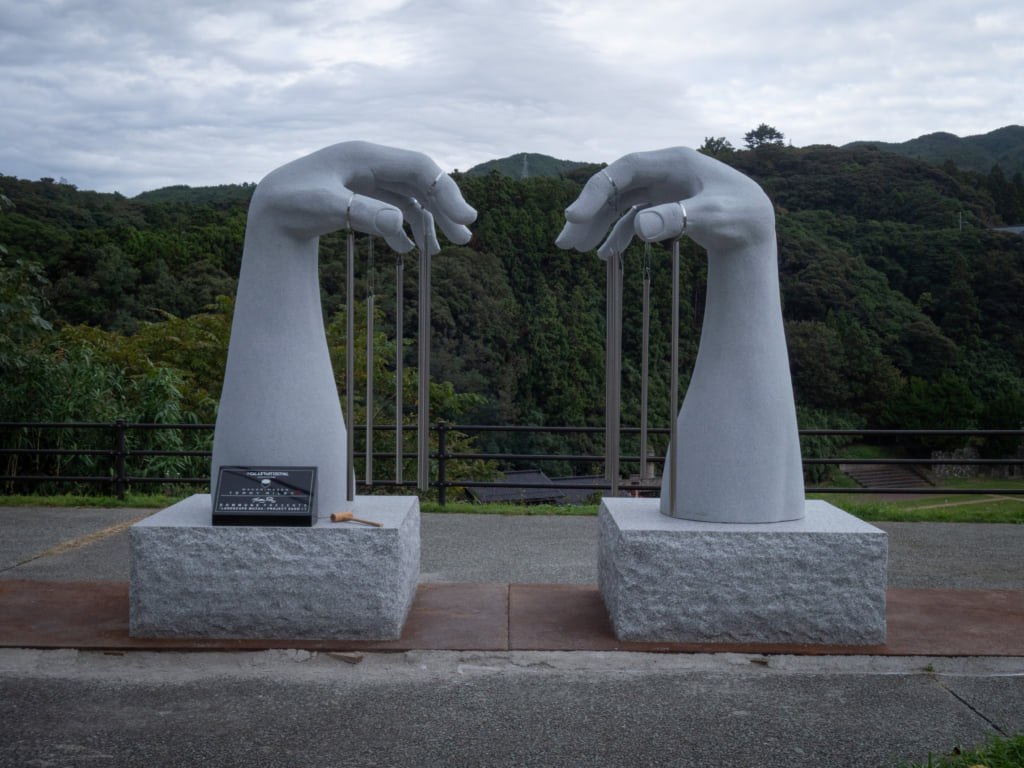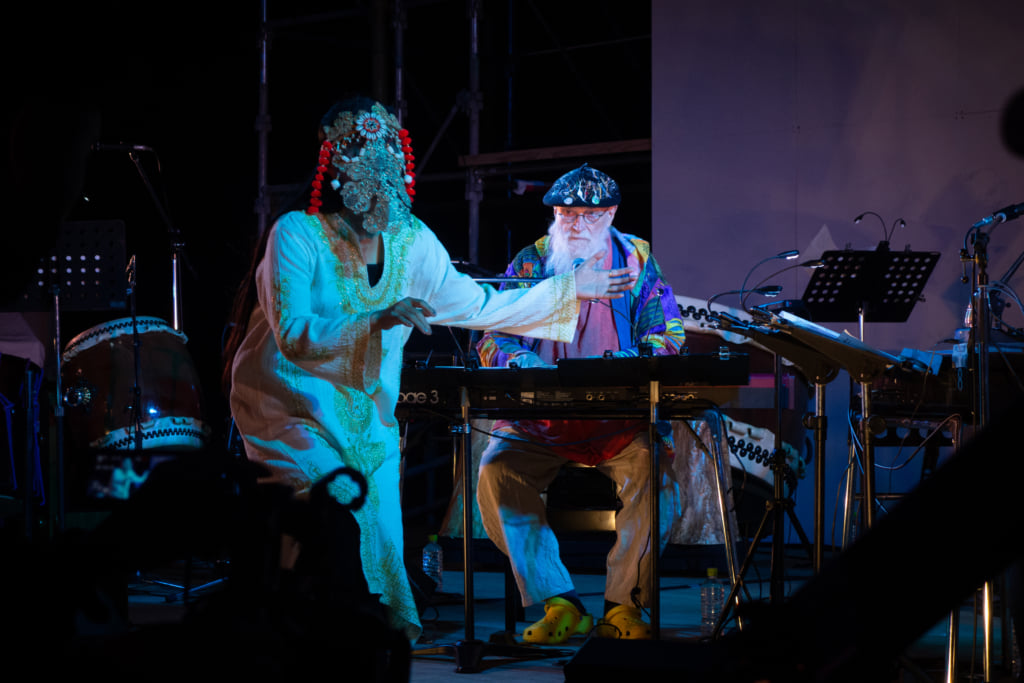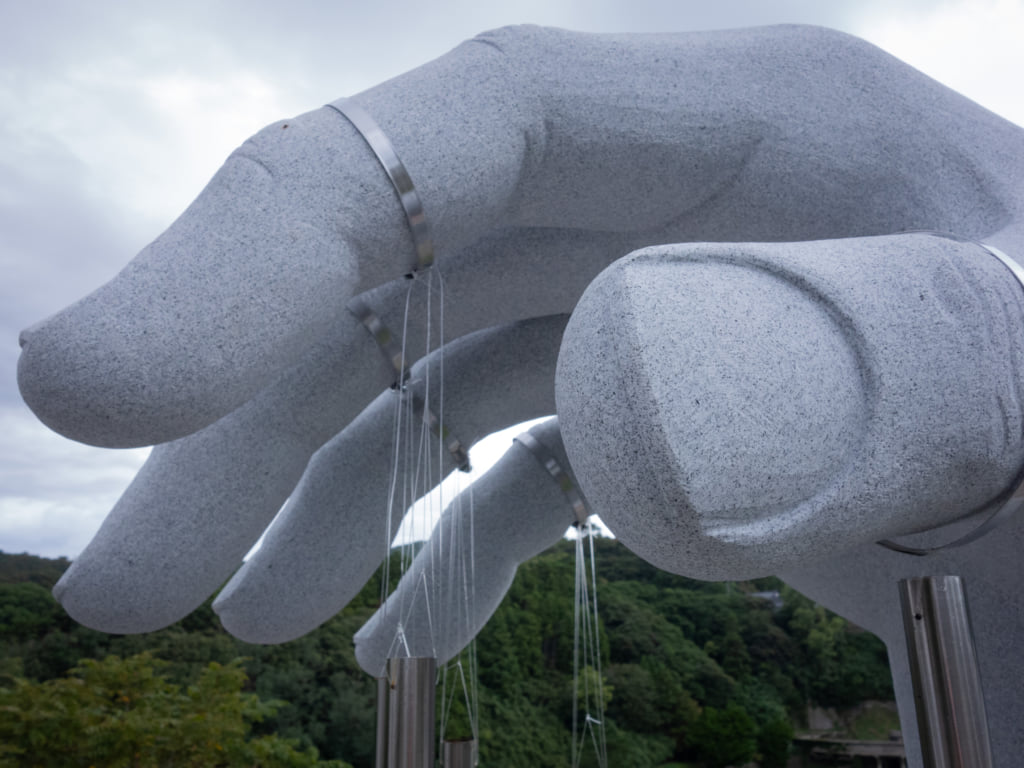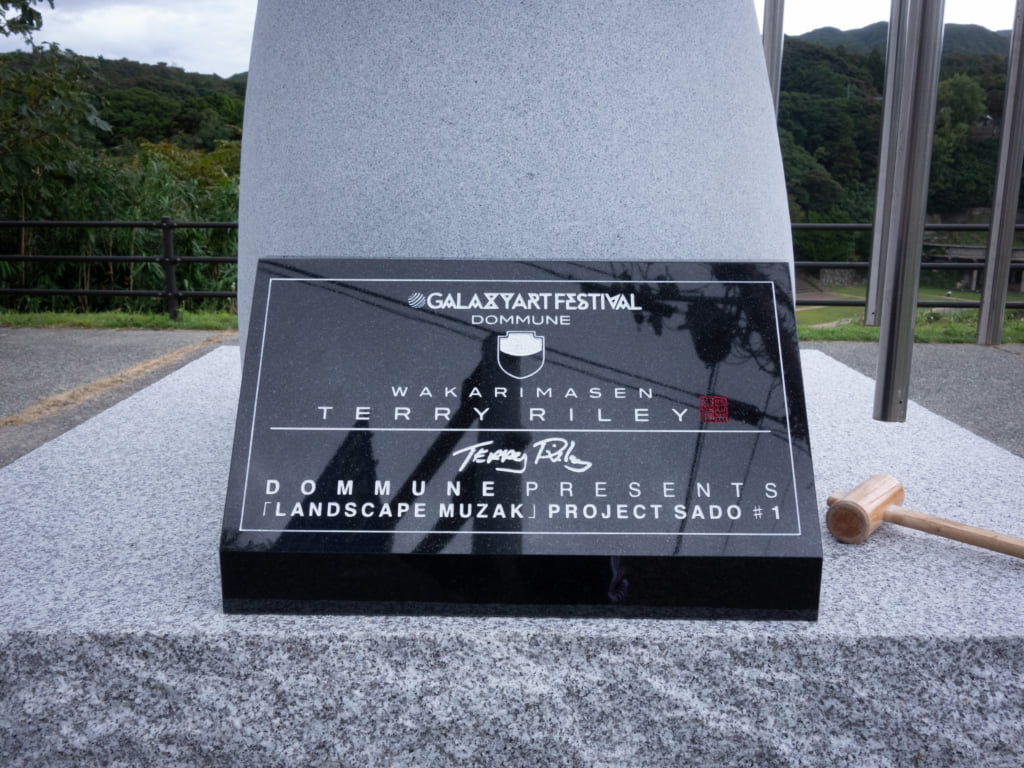An Acoustic Monument on Niigata Prefecture’s Sado Island
Terry Riley, one of the founders of minimal music, talks of the meanings behind this mythical sculpture.

Ukawa Naohiro, the President of the DOMMUNE livestreaming studio, is leading the LANDSCAPE MUZAK art project. Some two years after the project’s launch, the first acoustic monument was unveiled at Sado Island Galaxy Art 2021 in Sado City, Niigata Prefecture, in September 2021.
The artist for this first memorable edition is Terry Riley, one of the founders of minimal music and a master of contemporary music.
The background of the LANDSCAPE MUZAK project: how was this acoustic monument, designed to ‘last 1,000 years’ created? Project organizer Ukawa Naohiro, Terry Riley, and Miyamoto Sara, a disciple of Terry Riley, all delivered a talk at ‘FRACTAL CAMP’, held as a related event of Sado Island Galaxy Art 2021 the day before the event’s opening.
A soundtrack for a city that has touched hearts
Ukawa Naohiro (hereinafter referred to as ‘Ukawa’): LANDSCAPE MUZAK, DOMMUNE’s latest project at Sado Island Galaxy Arts Festival is a live performance in which musicians from all over the world visit Sado Island and give a soundtrack to the city that has touched their hearts. It is a non-stop project that involves live recording, then streaming, as well as sculpting the performers’ different world views by installing acoustic monuments all across Sado Island. I asked Terry to be the first artist in this project, which is why he has been in Japan for over a year and a half already.
Terry Riley (hereinafter referred to as ‘Terry’): I came to visit in February 2020, so it’s been 21 months.
Ukawa: Thank you so much, really. So, first of all, I came up with the concept for this project two years ago. At that point, I started to think that it would be a good idea to invite Terry as the first artist for LANDSCAPE MUZAC since I already knew his disciple, Miyamoto Sara, at that time; we’ve been in touch constantly for over two years now.
Miyamoto Sara (hereinafter referred to as ‘Sara’): Thank you for this wonderful opportunity.
Ukawa: This long-term project is finally getting off the ground with the live performances at ‘FRACTAL CAMP’ and the unveiling ceremony for the acoustic monument, so I would like to take a moment to look back on the project once more. Terry, you were originally planning to go on a tour starting in New York after visiting Sado in February 2020, right?
Terry: That’s right. I was planning to travel around Europe after the United States.
Ukawa: At that time, COVID-19 clusters were being discovered, infection was spreading onboard the Diamond Princess cruise ship, and the looseness of Japan’s infection control measures was being criticized all over the world. Given the situation in Japan, we were all deeply worried about whether it was a good idea to invite Terry to come inspect the location. I exchanged so many e-mails with Terry, and he eventually told me, ‘If I get infected with the virus, it’s my karma, so don’t worry.’ He made his decision and came to Japan, just like that. Our hearts were deeply moved by those words.
Terry: I see you remember quite well.
Ukawa: The shape of the LANDSCAPE MUZAK project would have been totally different if Terry hadn’t decided to come to Sado. We might have been forced to go forward while doing everything remotely, in a situation where it was impossible for Terry to actually visit Japan. Terry was 84 years old at the time, and since then he has celebrated his birthday twice here in Japan. During that time, we compiled the videos we shot of his inspection into a road movie and then recorded a live show outdoors. We made an acoustic monument together, and the project continued to move steadily forward. One of the things that made the strongest impression on me was that he never thought he would be making such a big life change after the age of 85.
Terry: I still feel that living in Japan right now is a truly miraculous experience.
Ukawa: Definitely. I think that Sara-san’s support was also very important.
Terry: I am so grateful to her; without her support, I would never have been able to get used to Japanese society and live normally.
Ukawa: May I ask you a little about what your teacher-disciple relationship is like?
Sara: Originally, Terry taught me how to sing raga, which is a kind of Indian classical music. I took lessons through video calls while Terry was living in the United States and I was living in Japan. Terry lived in the middle of the mountains and the Internet connection wasn’t very good. We sometimes found it difficult to communicate, but I was still at a loss when he told me he couldn’t continue to teach in this style anymore. I thought my life would involve repeated trips to America to take lessons before coming back to Japan.
Ukawa: I guess everything changed because of the pandemic, and our project.
Sara: That’s right. Thinking about how to ensure Terry’s safety during the COVID pandemic, I first had him stay in my hometown of Hokuto City in Yamanashi Prefecture, where my parents still had a house that had originally been for my grandmother. I was running about all last year to get him a long-term visa, for which I received a lot of help from the executive committee of the art festival.
Then, as I was supporting Terry in his daily life, I started to see how music exists in everyday life, and started to notice it in my everyday life, too. It’s not just about songs; he showed me how music could show us how to face the various headwinds we have in our lives.

The ‘WAKARIMASEN’ live performance was held as part of ‘FRACTAL CAMP’ which was a project of ‘Sado Island Galaxy Art 2021’ held in September 2021.
An Acoustic Monument ‘Lasting 1,000 Years’
Ukawa: LANDSCAPE MUZAK has become a project that will change Sara’s life. But how do you, Terry, feel about this project and its complex layers?
Terry: It is a big challenge for me also. Of course, I had the experience of making music to match the feeling of a place, for example in the White Cube Gallery, but it was the first time for me to go up against such a challenging concept on this scale. I really thought very deeply about creation, design, and about Ukawa-san’s call to ‘think about something that will remain for 1,000 years.’
The modern technology we use every day may no longer be used 1,000 years from now. That’s why I decided to create something without using technology. I decided to use chimes, which I also used in the song ‘WAKARIMASEN’ that I composed for this live show. There is an installation by this artist named Doug Aitken that is made up of 365 wind chimes, so it was also partly inspired by that.
Ukawa: Since the final work to be installed is a sound monument, well, there are hundreds of ways to emit sounds. Among them, we went with chimes when talking about the concept, because even after 1,000 years, the melody that Terry gave to Sado can be played just by hitting them.
What we call media art or, well, technology, in a nutshell, is evolving day by day. For example, we could have gotten a holographic Terry to appear and play. However, I thought that it could never be possible for such technology to survive in the same format and on the same devices for 1,000 years, which is why I asked Terry to think hard on this.
About the simplest way to play music. In other words, the sound of a fundamental human action such as hitting, stroking, crying, or banging. I think that this work is structured in such a way that it uses actions that allow Terry to share his experience of visiting Sado. You selected the site of the Kitazawa Floating Concentrator as the location for the installation. Could you please tell us why you chose that place?
Terry: When I saw that space, I thought of some ruins in Mexico. My first impression was that it looked like some ancient ruins rather than a gold mine or a mineral-processing site, and I personally like to think about the lives of the people who were there once; and what they thought of as important. I was really attracted to that place.
I also played there last year, and I wanted to install the sound monument somewhere overlooking that place. At first, I planned to put it on the hill near the temple’s bell, which I also visited with Ukawa-san. However, that location had some issues with the solidity of the ground, so I decided on the opposite hill for the location. However, I think that’s an even better place, because it now not only overlooks the mountain and the concentrator, which work as a kind of background, but it is also closer to the sea.
Ukawa: I heard that you found some common points between Sado and the West Coast of the United States, where you live. I also lived in San Francisco in the ‘90s. It was a great time, before all the gentrification. I lived there for three years, and I heard about all the miners who flooded the area looking for gold in the 1850s. But what other common points did you find?
Terry: Well, first of all, the coastline. Sado’s coastline is remarkably similar to the coastline of Northern California, where I live. That’s just north of San Francisco, but Sado is also sometimes quite similar in terms of its climate, as well. And, as you said, there was a gold rush era in California’s Sierra Nevada in the 1850s. So, feeling these topographical and climatic links, playing in this mineral processing plant where I could feel the remnants of the past made me feel such a rich connection.

A stone statue that imitates a person’s hand. The material used is stone from India, the country where Terry Riley learned music philosophy.
Reflecting back on the indigenous environment of Sado
Ukawa: As you see in the photo, we are creating this huge monument; a three-dimensional work made by Terry’s hands. This stone statue was made in China, but the important point is the stone. Since Terry learned music philosophy in India, I chose Indian stones.
Terry: I didn’t know that. I’m really surprised.
Ukawa: The reason why I decided to do this Soundscape project was that there was something that really caught my attention when I visited Sado with Ikeda Tetsuo, Professor Emeritus of Niigata University, before the inspection with Terry. I think it’s the first time I’m mentioning this to Terry and Sara, but there are many animal memorial stones in Sado. There is no whaling here in Sado, but it does seem like this one huge whale was beached here a few hundred years ago. Since then, whales are still beached here once in a while, and I began to notice that there were several whale memorials in Sado. As far as the Professor told me, there are three.
Interestingly, the memorials clearly state who in each village received which part of the whale, and how many grams. In other words, the whales that washed up on the beach and died were gratefully received as a blessing from the sea. The local residents shared the whale’s body as a source of life, enriching their own lives. The details of this are engraved as data on the stones and handed down to the present day. I think it’s really quite remarkable, I mean, it’s as if we took some receipts, household accounts, and the breakdown of the village’s accounting budget and engraved all that in stone to record it for hundreds of years. That’s basically what they did (laughs). It’s a really amazing story, isn’t it?
Terry: That’s a very interesting point of view.
Ukawa: So, our LANDSCAPE MUZAK project is about Sado Island’s indigenous environment and recording the trip that Terry took to each village and the creativity that he found there. Then, we at DOMMUNE carry out the production and the installations on Sado Island, creating an irreplaceable collaboration. And its title became ‘WAKARIMASEN’. In other words, just like ‘I will now humbly receive’ (itadakimasu) and ‘That was delicious’ (gochisousama) that exist from 300 years ago, Terry’s feelings of ‘not understanding’ (wakarimasen) and their sounds will continue to reverberate and make their way into people’s hearts 1,000 years from now. This is why I landed on the idea of a sound monument, as that kind of a memorial.
I think that another aspect is the story of Terry himself, which is at the origin of this project and which will remain in this village. In other words, Terry came down to Sado despite the COVID-19 pandemic and experienced the island. However, because of the increase in infections in his home country, he could not leave Japan and decided to move here. And the sounds that were born from the relationships he created here in Japan will remain for 1,000, 2,000 years. I would be very happy if everyone could really grasp and experience the fact that this work will remain installed on Sado Island for such a mythical, long span of time. The unveiling will be the day after tomorrow. And tomorrow, there will be Terry’s live performance that he talked about today, so I hope you will be able to experience all of that.
Terry: Thank you very much. It’s magnificent. To just add a little to this concept of ‘WAKARIMASEN’, I want to convey this idea that we do not unilaterally conclude things about nature, or spirituality, but rather continue to learn humbly, thinking, ‘I don’t understand’ (wakarimasen). I chose the title of the work with the desire to always have this feeling.
Ukawa: That’s wonderful! If itadakimasu and gochisousama represent gratitude, then wakarimasen is a humble feeling of learning. And it will remain for 1,000 years. Terry, thank you very much for your collaboration over these past 21 months.
Sara: I think it really makes a lot of sense for Ukawa-san to create such a project, in this time where it seems natural for everything to just flow on by. Thank you very much.
Ukawa: No, thank you. Finally, the reason I chose stone is simply because I wanted it to remain for 1,000 years. I also love media art (laughs), but this project would be meaningless if we built it in terms of technology that can be consumed. Stone is this very basic medium. As Sara said, there is too much media that just flows by, especially SNS. Everything gets logged on the news, but the flow just gets faster and faster. I was looking for an absolutely basic medium in this raging kind of information society. And that was stone. This time, I focused on the art and folk tales that get carved in stone. And since this folk tale is still a story, I think it will grow into a myth over time.

The ‘WAKARIMASEN’ acoustic monument is installed in a location near the site of the Kitazawa Floating Concentrator in the Aikawa/Kitazawa area of Sado Island.
The ‘WAKARIMASEN’ live performance by Terry Riley and Miyamoto Sara can be enjoyed through a paid archive broadcast.
Broadcast period: 01/11 – 31/12/2021
Price: 3,000 yen
Distribution contents:
・DOMMUNE Presents ‘LANDSCAPE MUZAK’ PROJECT SADO #1 Terry Riley live performance ‘WAKARIMASEN’ with Kodo, Salyu
・Haino Keiji
・OLAibi
・Kakudo Mami
・solo solo solo
・Oni Taiko Performance
・Oyasumi Mood Mune (MOODMAN+YOSHIROTTEN+KANATAN) etc.
<Tickets>
fractalcampondommune2.peatix.com<Tickets with official goods>
sado-art.shop-pro.jp/<Official Site>
sado-art.com/TRENDING
-
A House from the Taisho Era Reveals Its Secrets
While visiting an abandoned building, Hamish Campbell discovered photographs the owner had taken of the place in the 1920s.

-
The Taboo-Breaking Erotica of Toshio Saeki
The master of the 1970s Japanese avant-garde reimagined his most iconic artworks for a limited box set with silkscreen artist Fumie Taniyama.

-
With Meisa Fujishiro, Tokyo's Nudes Stand Tall
In the series 'Sketches of Tokyo', the photographer revisits the genre by bringing it face to face with the capital's architecture.

-
Masahisa Fukase's Family Portraits
In his series ‘Family’, the photographer compiles surprising photos in which he questions death, the inescapable.

-
Hajime Sorayama's Futuristic Eroticism
The illustrator is the pioneer for a form of hyperrealism that combines sensuality and technology and depicts sexualised robots.





